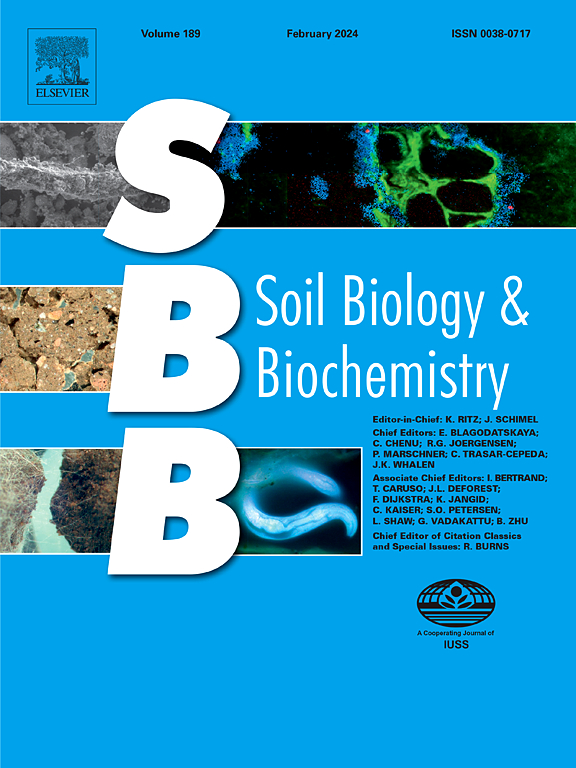向土壤中添加生物有效碳,促进游离氮固氮和微生物生物量的生长
IF 9.8
1区 农林科学
Q1 SOIL SCIENCE
引用次数: 0
摘要
在全球范围内,土壤中自由生活重氮营养菌对大气氮(N2)的固定过程对土壤氮供应有重要贡献,但对其驱动因素,特别是能量可用性的作用的了解有限。在本研究中,我们通过微生物15N2培养实验,探讨了两种不同的能量来源,即模拟高生物有效性根系分泌物的人工碳输入和需要分解的土壤有机质的自然梯度,如何影响自由生活重氮营养体对N2的固定和土壤微生物群落的功能。我们分析了15N进入土壤的情况,并通过非靶向脂质组学方法使用质谱法测定微生物脂质,作为微生物群落功能的指标。我们的研究结果表明,自由生活重氮营养菌具有显著的固氮能力,每公顷每年可储存111公斤氮。添加人工渗出液可额外获得51 kg N ha-1y-1。这种氮固定伴随着微生物群落中可能的氮限制,因为生物量的增长有利于无氮脂质,与储存(三酰基甘油)和结构膜脂质的合成相同。虽然能量添加促进了氮的吸收,特别是在有机质含量低的土壤中,但在有机质含量高的土壤中,氮的吸收自然更高(额外的20 kg N ha-1y-1),同时膜相关脂质的水平也增加,这表明微生物群落更大。我们的研究结果表明,在高产植物群落的潜在驱动下,根分泌物的增加可以缓解自由生活重氮营养固氮作为重要土壤微生物群落的一部分的能量限制。这些见解支持可持续农业实践的发展,通过自由生活的重氮营养体刺激固氮能力,旨在通过最大限度地减少施肥造成的氮损失来维持生态平衡。本文章由计算机程序翻译,如有差异,请以英文原文为准。


Bioavailable carbon additions to soil promote free-living nitrogen fixation and microbial biomass growth with N-free lipids
Globally, the process of atmospheric nitrogen (N2) fixation by free-living diazotrophs in soils contributes significantly to the soil N supply, yet the understanding of its driving factors, particularly the role of energy availability, is limited. In this study, we explored how two different energy sources, an artificial carbon input, simulating highly bioavailable root exudates, and a natural gradient in soil organic matter that requires decomposition, affect N2 fixation by free-living diazotrophs and soil microbial community functions through microcosm 15N2 incubation experiments. We analysed the incorporation of 15N into soil and used mass spectrometry to determine microbial lipids, which serve as indicators of microbial community functions, via an untargeted lipidomics approach. Our findings demonstrate a significant capacity for N2 fixation by free-living diazotrophs, with a potential annual storage of 111 kg N per hectare. The addition of artificial exudates yielded an extra of 51 kg N ha−1y−1. This N2 fixation was accompanied by a presumable N limitation in the microbial community, as biomass growth favoured N-free lipids with an equal synthesis of storage (triacylglycerols) and structural membrane lipids. While energy addition boosted N uptake particularly in soils with low organic matter, in soils rich in organic matter, N uptake was naturally higher (an extra 20 kg N ha−1y−1), along with increased levels of membrane-associated lipids, suggesting a larger microbial community. Our results imply that enhanced root exudation, potentially driven by more productive plant communities, could mitigate the energy constraints on free-living diazotrophic N2 fixation as part of a vital soil microbial community. These insights support the development of sustainable agricultural practices that stimulate the capacity for N2 fixation by free-living diazotrophs, aiming to maintain ecological balance by minimising N loss from fertilisation.
求助全文
通过发布文献求助,成功后即可免费获取论文全文。
去求助
来源期刊

Soil Biology & Biochemistry
农林科学-土壤科学
CiteScore
16.90
自引率
9.30%
发文量
312
审稿时长
49 days
期刊介绍:
Soil Biology & Biochemistry publishes original research articles of international significance focusing on biological processes in soil and their applications to soil and environmental quality. Major topics include the ecology and biochemical processes of soil organisms, their effects on the environment, and interactions with plants. The journal also welcomes state-of-the-art reviews and discussions on contemporary research in soil biology and biochemistry.
 求助内容:
求助内容: 应助结果提醒方式:
应助结果提醒方式:


